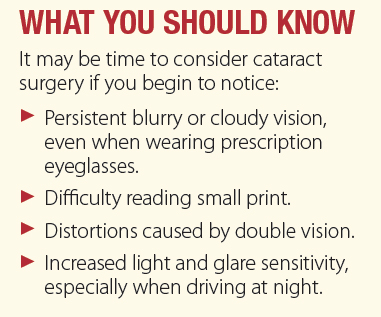Cataract Surgery Can Help You Regain Crisp Vibrant Vision
At some point during your 50s or 60s, your vision may have lost some of its vibrancy. Even when you’re wearing prescription eyeglasses, things began to be a bit blurry, hazy, or less colorful. This is what it feels like to have a cataract, which is the term for what occurs when the lens in the eye becomes clouded—a natural process that occurs with age. The role of the lens is to help you focus on objects at varying distances: close up for things like reading and knitting; distance for activities like driving and golf, and mid-range for everything in between.
If cataracts are detected early—at stage 1 or 2—you’ll have some time before surgery is necessary. But if cataracts have developed—or ripened—to stage 3 or 4, where they affect your ability to drive, read, or work, it’s time for cataract surgery.
Safe Surgery
Cataracts affect more than 25 million Americans, 61 percent of whom are women— and cataract surgery is among the most frequently performed and safest surgeries worldwide. Cataract surgery involves removal of the clouded lens and replacement with a clear artificial intraocular lens (IOL). This is done as an outpatient procedure that takes less than 30 minutes, and in most instances is covered by Medicare and most private insurance. “Today, cataract surgery is safe in more than 95 percent of patients,” says Ana Alzaga Fernandez, MD, assistant professor of ophthalmology at Weill Cornell Medicine.
Standard IOL vs. Premium IOL
In most cases, a monofocal IOL is used to replace the clouded lens. This is the standard lens that has been successfully implanted for decades and is 100 percent covered by Medicare and private insurance. The monofocal IOL is designed to provide the best possible vision at one distance. Most people who choose a monofocal IOL have it set for distance vision, and they use reading glasses for near-vision tasks, such as reading and crafts. “In some instances, however, patients decide to have the IOL set for near vision so they don’t need glasses for reading. In those cases, the patient is fit for prescription eyeglasses for driving and other activities that require distance vision,” explains Dr. Fernandez.
There are also advanced IOLs—known as premium IOLs. While premium IOLs aim to reduce dependence on glasses after cataract surgery, the extent to which that occurs varies from patient to patient. They are more expensive than monofocal IOLs and are rarely covered by insurance. Examples of premium IOLs include multifocal IOLs, which enable near and distance vision and the Light-Adjustable Lens (LAL), which allows for the prescription of the lens to be tweaked after the eye heals. The healing process can microscopically change the patient’s vision prescription, and this lens gives the surgeon the ability to compensate for that. The surgeon uses ultraviolet light to adjust the lens strength during a postoperative office visit. Sometimes more than one visit is necessary to get the strength just right.

How Cataract Surgery Is Performed
In most cases, the patient receives a mild sedative that is administered intravenously along with numbing eye drops. “The intravenous medication allows for the patient to feel more at ease while still remaining awake and able to follow directions during surgery,” explains Dr. Fernandez.
Phacoemulsification is the predominant method of performing cataract surgery. The surgeon makes a tiny incision in the eye and then inserts the phacoemulsification probe, which uses ultrasound vibrations to break the clouded lens into small pieces, and suction to remove the fragments. Once the fragments are gone, the surgeon implants the IOL.
A newer surgery technique—femtosecond laser-assisted cataract surgery (FLACS)—uses a laser to perform several of the surgery’s steps, but the surgeon still uses the phacoemulsification probe to remove the pieces of the cataract. Enhanced precision and reduced healing time are two possible benefits associated with FLACS, but studies show there is no advantage as far as visual outcome. Also, FLACS is not covered 100 percent by Medicare or private insurance.
Restoring Youthful Vision
Cataract surgery is a highly effective procedure that can make everyday activities easier and safer by restoring the visual function that you enjoyed in your younger years. An annual eye exam can help your ophthalmologist diagnose your cataract early, which will give you the option to wait and schedule the procedure when you are ready to have it.
The post Cataract Surgery Can Help You Regain Crisp Vibrant Vision appeared first on University Health News.
Read Original Article: Cataract Surgery Can Help You Regain Crisp Vibrant Vision »

